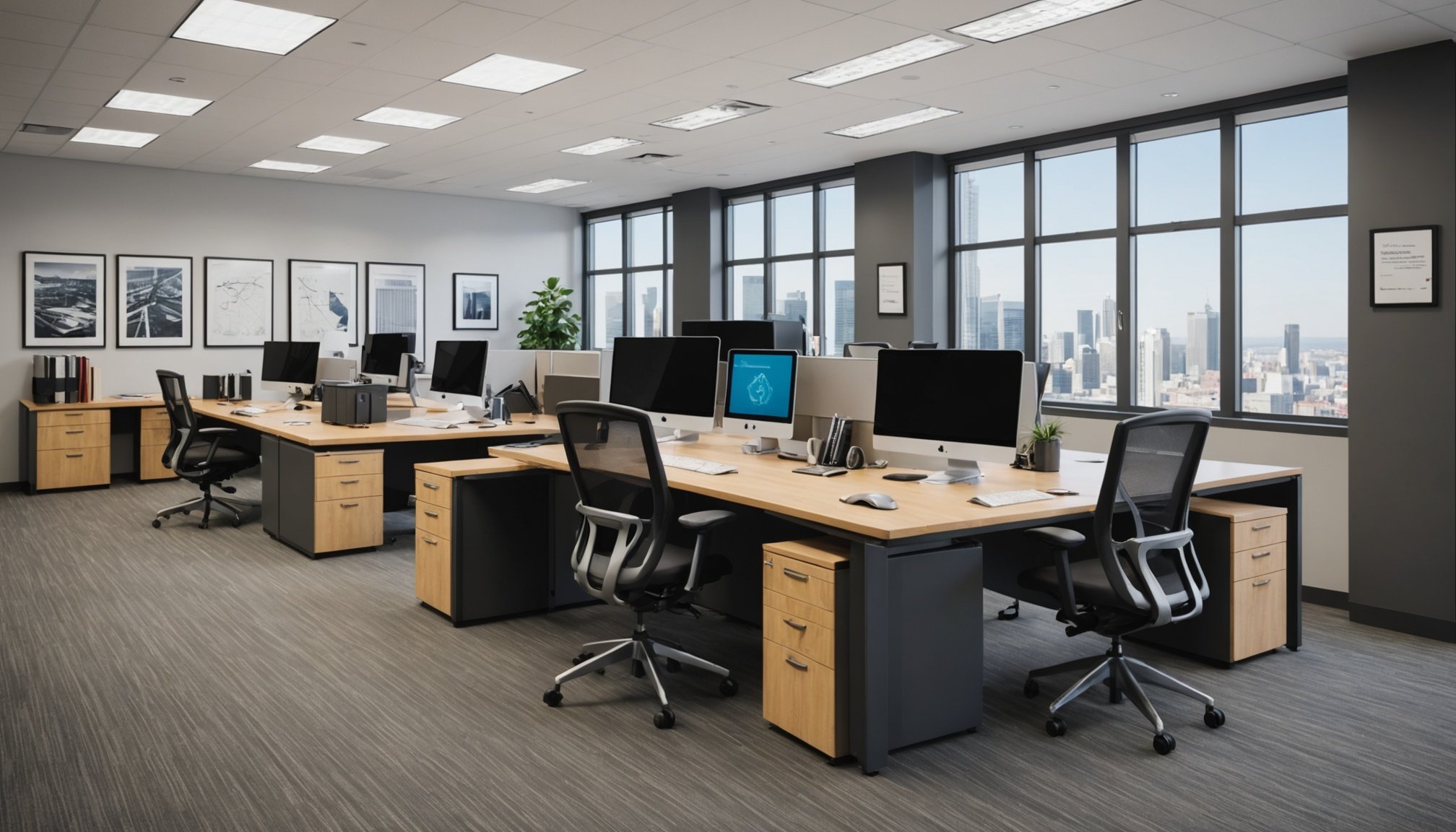Understanding Ergonomic Design Principles
Ergonomic design is a critical component in creating office environments that foster productivity and promote wellness. At its core, ergonomic design aims to tailor the workplace to fit the needs of its users, reducing discomfort and preventing injuries.
Key principles of ergonomic design include:
Also read : Exploring the soothing powers of forest bathing: how immersion in nature lowers stress levels
-
Chair height: Essential for maintaining natural body posture. Proper chair height ensures feet rest flat on the floor, thighs are parallel to the ground, and arms form a 90-degree angle with the desk.
-
Desk setup: A well-arranged desk helps minimise strain on the body. Ideally, frequently used items should be within easy reach, and work surfaces should accommodate all necessary equipment without overcrowding.
Additional reading : Revolutionizing copd management: the life-changing benefits of well-designed exercise programs
-
Monitor placement: Position the monitor at eye level and about an arm’s length away to reduce neck and eye strain.
Integrating these principles into an office setup can notably impact employee health and productivity. When employees operate in a well-designed environment, they experience fewer physical strains, increasing focus and efficiency. Furthermore, prioritising workplace wellness through ergonomic practices can lead to happier, healthier employees, reducing absenteeism and improving morale. Understanding and acting upon these ergonomic principles is fundamental in cultivating successful, sustainable office environments.
Common Repetitive Strain Injuries in the Workplace
Repetitive strain injuries (RSIs) are prevalent workplace injuries that often affect office workers engaged in constant typing or mouse use. Carpal tunnel syndrome and tendinitis are two common RSIs. Carpal tunnel syndrome, for instance, occurs due to pressure on the median nerve within the wrist, leading to numbness and discomfort. Tendinitis involves inflammation of tendons, often resulting from repetitive movements or awkward postures, severely impacting employees’ productivity and well-being.
Research indicates that RSIs are a significant issue, affecting nearly 23% of the workforce, thus emphasizing the importance of preventive measures. These injuries not only result in physical discomfort but can also lead to decreased productivity and increased absenteeism, directly affecting a company’s operational efficiency.
Efforts to mitigate RSIs include ergonomic interventions and regular breaks, aiding in alleviating fatigue and muscle tension. Understanding the nature of these injuries is vital for implementing effective solutions. Emphasizing employee wellness through ergonomic practices inherently reduces the risk of such injuries, fostering a healthier, more productive work environment. Make sure to engage staff in recognising symptoms early to prevent further complications and promote active workplace wellness.
Design Recommendations for Preventing RSIs
Creating a workspace with ergonomic office furniture and tools is essential in preventing repetitive strain injuries (RSIs). Ergonomic workstations, including chairs, desks, and equipment, can significantly enhance both comfort and productivity.
Ergonomic Workstations
Incorporate adjustable workstations that allow employees to modify their environments to suit their needs. These alterations ensure employees maintain proper posture throughout the day. Ergonomic chairs should have adjustable heights and backrests to support spinal curves, promoting comfort. Proper desks with adjustable heights accommodate various tasks seamlessly.
Adjustable Equipment
Ensure that all equipment, such as monitors and keyboards, is adjustable. This adaptability encourages neutral postures and minimizes strain. Users should position monitors at eye level and around an arm’s length away. Ergonomic keyboards and mice reduce stress on hands and wrists, essential in minimizing the risk of RSIs.
Proper Accessories
Accessories like document holders and footrests can further enhance workplace ergonomics. Document holders keep materials at eye level, reducing neck strain, while footrests help maintain a natural posture. Incorporating these ergonomic tools and furniture is not only about comfort but also fosters long-term health and productivity.
Implementing Ergonomic Solutions in the Workplace
Implementing workplace ergonomics effectively starts with detailed ergonomic assessments. These assessments help identify areas within the office setup needing adjustments to enhance comfort and productivity. By examining aspects like furniture arrangement and equipment use, businesses can pinpoint where ergonomic improvements are necessary.
Integrating ergonomic design into existing office setups involves reconfiguring workspaces to follow ergonomic principles, such as proper chair height and monitor placement. This transformation may include investing in ergonomic furniture and tools to ensure workstations are adjustable and supportive. Offering height-adjustable desks and chairs, along with repositionable monitors, enables employees to personalise their environments to maintain optimal postures.
Employee training is crucial in recognising and preventing repetitive strain injuries (RSIs). By educating staff on ergonomic practices and RSI symptoms, organisations empower them to take proactive measures in maintaining workplace wellness. Training sessions can cover topics like correct chair adjustments, positioning of equipment, and the importance of regular breaks to alleviate strain.
Ultimately, a strong strategy for implementing ergonomic solutions not only prioritises employee health but also enhances overall productivity, leading to a more harmonious and efficient office environment.
Case Studies on Ergonomic Interventions
Exploring ergonomics case studies reveals notable improvements in workplace efficiency and employee well-being when ergonomic designs are effectively implemented. For instance, a major tech company revamped its office layout with adjustable desks and chairs. The organization observed a 25% reduction in reported workplace injuries and a remarkable upswing in employee morale.
Another example showcases a healthcare provider that introduced ergonomic keyboards and proper monitor placements. This intervention led to significantly fewer complaints of neck and wrist pain, enhancing overall workplace wellness and boosting job satisfaction among staff.
These organizational examples underscore the tangible benefits ergonomic interventions can deliver. Reduced absenteeism and a healthier workplace culture are common outcomes, as employees feel valued and supported.
Lessons from these case studies emphasize the importance of regularly reviewing and adjusting workplace ergonomics. By learning from successful examples, businesses can tailor interventions to their specific needs, creating a more productive and positive environment. Companies looking to enhance their office ergonomics can draw valuable insights from these real-world applications, enabling them to adopt effective strategies that align with organizational goals and employee needs.
Conclusion: The Future of Office Design
The future of ergonomics is set to transform traditional office landscapes through innovative trends and cutting-edge technology. As more organizations recognize the value of workplace innovation, we are witnessing a shift towards increasingly adaptable environments.
Emerging trends such as virtual reality and AI are expected to play pivotal roles in shaping office design. Virtual reality can provide immersive training sessions on proper ergonomic practices, enhancing employee learning and engagement. Moreover, AI-driven tools can offer real-time posture corrections, ensuring continuous support for users as they navigate their daily tasks.
Flexibility is a cornerstone of future office environments, tailored to accommodate dynamic workstyles. This involves adjustable, multi-purpose workstations that adapt effortlessly to various tasks and user preferences. The agile nature of modern office spaces ensures that employees can adjust their surroundings to maintain optimal comfort and productivity.
Looking ahead, ergonomic practices will likely evolve to emphasize holistic wellness, integrating mental and physical health considerations into design. As workplaces continue to innovate, the commitment to ergonomics promises not only healthier employees but also a thriving organizational culture that champions well-being and efficiency.











